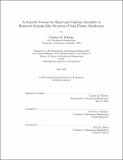| dc.contributor.advisor | Martin L. Culpepper. | en_US |
| dc.contributor.author | Wheeler, Charles M. (Charles Michael) | en_US |
| dc.contributor.other | Massachusetts Institute of Technology. Department of Mechanical Engineering. | en_US |
| dc.date.accessioned | 2015-12-16T15:54:45Z | |
| dc.date.available | 2015-12-16T15:54:45Z | |
| dc.date.copyright | 2015 | en_US |
| dc.date.issued | 2015 | en_US |
| dc.identifier.uri | http://hdl.handle.net/1721.1/100307 | |
| dc.description | Thesis: S.M., Massachusetts Institute of Technology, Department of Mechanical Engineering, 2015. | en_US |
| dc.description | This electronic version was submitted by the student author. The certified thesis is available in the Institute Archives and Special Collections. | en_US |
| dc.description | Cataloged from student-submitted PDF version of thesis. | en_US |
| dc.description | Includes bibliographical references (pages 88-90). | en_US |
| dc.description.abstract | The purpose of this work is the modeling and prototyping of a highly parallelized process capable of folding large and compliant two-dimensional sheets into ordered, three-dimensional structures. The direct application of this work is the assembly of tissue scaffolds for replacement of human tissues and organs. A folding process capable of creating complex 3D geometries in a highly parallel, highly uniform fashion would enable the production of tissue scaffolds or other flexible systems at a fraction of the cost and time required by competing methods such as 3D printing. No existing research has attempted to apply folding to the manufacture of artificial organs and tissues; this work is the first to do so. This thesis introduces "membrane-driven folding," a process whereby pre-strained elastic membranes are used to drive folding. Rules for constraint and actuation, governing kinematic equations, and design rules necessary to implement this process are presented. These are then translated into functional requirements and a design for a prototype machine employing this process. This prototype machine is then tested and demonstrated to successfully achieve folding using this highly parallel, membrane-driven approach. | en_US |
| dc.description.statementofresponsibility | by Charles M. Wheeler. | en_US |
| dc.format.extent | 100 pages | en_US |
| dc.language.iso | eng | en_US |
| dc.publisher | Massachusetts Institute of Technology | en_US |
| dc.rights | M.I.T. theses are protected by copyright. They may be viewed from this source for any purpose, but reproduction or distribution in any format is prohibited without written permission. See provided URL for inquiries about permission. | en_US |
| dc.rights.uri | http://dspace.mit.edu/handle/1721.1/7582 | en_US |
| dc.subject | Mechanical Engineering. | en_US |
| dc.title | A scalable process for rapid and uniform assembly of repeated origami-like structures using elastic membranes | en_US |
| dc.type | Thesis | en_US |
| dc.description.degree | S.M. | en_US |
| dc.contributor.department | Massachusetts Institute of Technology. Department of Mechanical Engineering | |
| dc.identifier.oclc | 931033217 | en_US |
